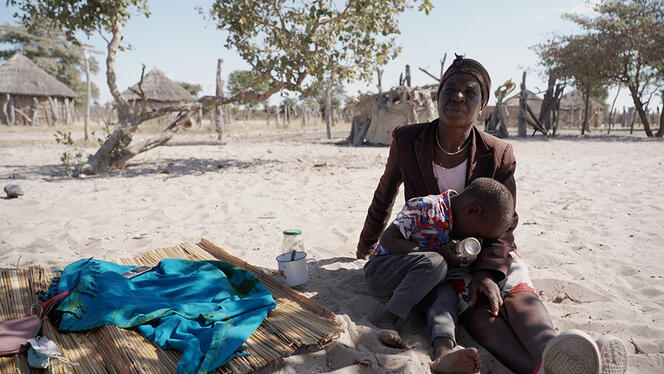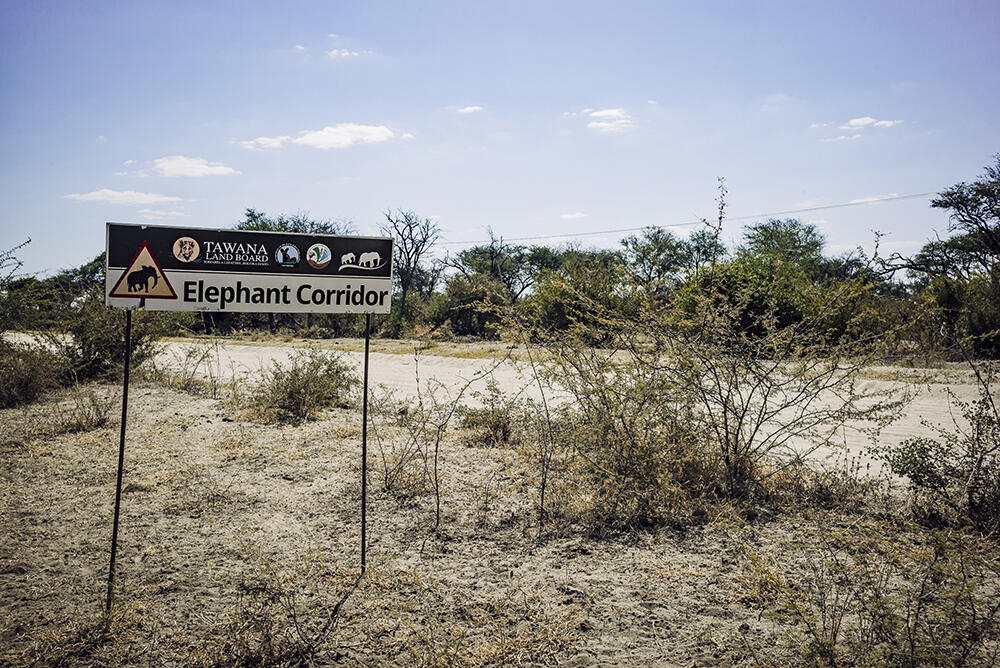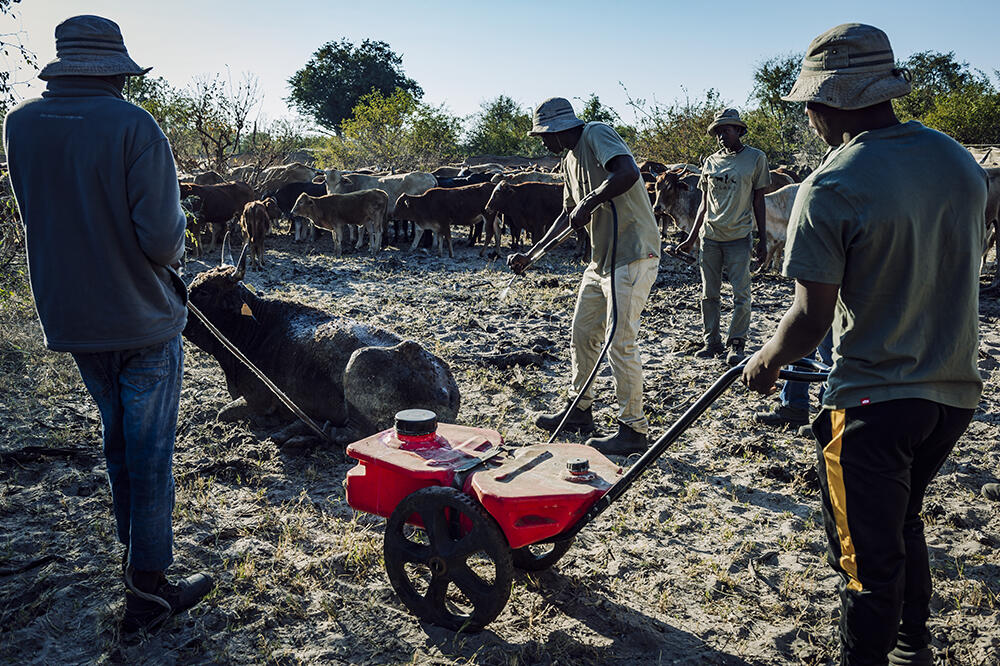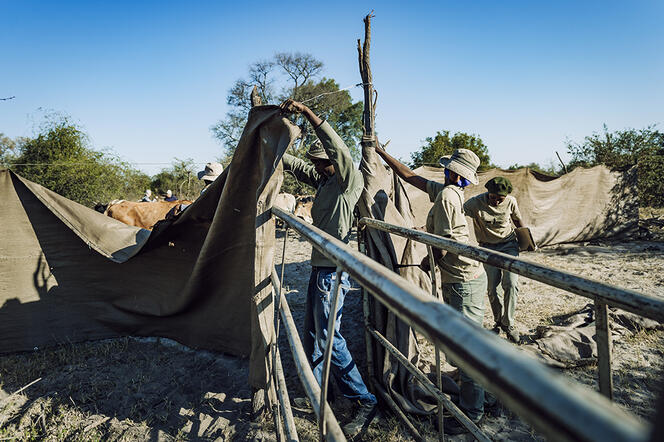You are here
Reconciling people and wildlife in the Okavango

On 14 April, 2018, Kenna Baitishwenye’s life was turned upside down. Her husband died on the road between the hamlet of Ndorotsa and the nearby village of Seronga – killed by an elephant. “A female came out of the bush with her calf. She was on her way to the river to drink and didn’t see my husband,” the widow told us when we met in early July 2022, under a tree in her yard, surrounded by family and neighbours.
Tragedies like this strike every two or three years in the Seronga district. The large number of pachyderms in the region, especially during the dry season when they roam back and forth between the bush and the life-sustaining delta, poses a constant threat to thousands of inhabitants. In the early morning hours or at nightfall it is nearly impossible to travel safely outside the villages. “Our lives are in danger because of the elephants,” a neighbour named Tsekelio Tsheko complains in Sehumbukushu, one of the languages spoken in Botswana. “It’s a problem when we go down to the river, it’s a problem when we go out to the fields, it’s a problem when the children go to school…” And, according to the villagers, the situation has worsened considerably in the past ten years.
16,000 people – and just as many elephants
The numbers speak for themselves: “The Panhandle, the far northern region of the Okavango Delta, has a population of 16,000, plus 16,000 head of cattle and… 16,000 elephants,” reports Richard Fynn, a researcher at the Okavango Research Institute (ORI) and the coordinator in Botswana of the ProSuLi (short for Promoting Sustainable Livelihoods) project. The latter was launched in 2018 in cooperation with the French agricultural research and international cooperation organisation (CIRAD), the CNRS (see box story below) and Zimbabwe’s National University of Science and Technology (NUST), with the goal of improving living conditions for human populations in and near wildlife protection areas.
On the scale of the African continent, the bush elephant is an endangered species, having lost half of its population in a span of 40 years (from 1 million to 450,000 individuals). But this is not the case in Botswana, where their numbers rocketed by 300% between 1992 and 2012, reaching an estimated total of 130,000 individuals and making the country a sanctuary for the animals. Besides the tragic accidents, the damage they cause to crops weighs heavily on the fragile economy of the villages in the Panhandle. Countless fields of food crops like sorghum, millet and pumpkin have been ravaged by elephants. There are few fences that can deter these behemoths, and the plastic bottles placed on poles to scare them off seem to have little or no effect.
“The problem with the conservation zones, as they were set up under colonial administrations and as they continue to be managed by most African countries,” Fynn points out, “is that they are of no benefit to the populations who live nearby and suffer all the drawbacks: crop damage, as well as losses due to carnivores like lions, which attack the cattle grazing in the floodplains.” As a result, lions are regularly poisoned in retaliation and instances of elephant poaching are on the rise, according to the researcher who would like to see the Panhandle villagers fully involved in the governance of the northern delta protected areas, and deriving genuine benefits from them. “Most often, the government just gives the locals a little money to compensate for the loss of their land, and occasionally offers them jobs in the tourism industry. But that doesn’t provide livelihoods for whole villages, and doesn’t give them back their rights.”
ProSuLi, a project built with the villagers
Several initiatives have been launched in the region in recent years through the action of nature conservation NGOs. For example, a project by EcoExist has identified the paths used most often by pachyderms. These “elephant corridors”, several hundred metres wide, are now indicated by signs visible from the road and are taken into account by the local Landboard, the commission that allocates land to villagers, to keep them separate from the plots used to grow crops. A more recent initiative by the NGO Claws, whose mission is to improve the coexistence of humans and lions, provides part of the basis for the ProSuLi research project.
The Okavango Delta protection area is actually included in a larger conservation zone straddling five neighbouring countries. Called the Kavango-Zambezi Transfrontier Conservation Area, or Kaza TFCA, it unites Namibia, Angola, Botswana, Zambia and Zimbabwe. Indeed, wildlife knows no borders… “Although this TFCA, like the 17 others currently in operation in southern Africa, was founded on a two-pronged philosophy – to contribute to the protection of wildlife while participating in the socio-economic development of the local populations – it must be admitted that the people too often come second,” laments Alexandre Caron, the CIRAD researcher who serves as ProSuLi project coordinator.
Active at four locations in the Kaza TFCA, the project is unique in that it takes the opposite approach, focusing solely on the inhabitants’ living conditions. With an original strategy: rather than arriving with preconceived ideas of the actions to be taken, the researchers literally co-define the project’s activities in cooperation with the villagers through the organisation of participatory workshops – a method that the CIRAD has been favouring for several years now. As a result, one issue has emerged as the highest priority in the Panhandle: livestock management. “Everyone here owns cattle,” Caron explains. “It’s like a savings account for the people of the Panhandle. They sell a cow to finance a wedding, a funeral… Seeing their cattle attacked by lions is clearly a problem, but not the only one. Other than those occasional sales, there is no real market for livestock that can provide a regular income for a family.”

Foot-and-mouth disease is prevalent in the delta, and the region’s cattle sell for one-fifth to one-sixth the prices paid elsewhere in Botswana. Livestock trade is made even more difficult by the lack of a slaughterhouse in the area. The animals have to be transported to Maun, the main city of the Okavango Delta, more than nine hours away by truck on a rough, worn-out trail. For these reasons, several initiatives have been taken to improve not only the protection of the livestock, but also their market value.
A source of income for the population
To find out more, we went early one morning to meet Lentletse Phuti and his team of six young cowherds just outside the village of Eretsha. They were already hard at work: inside a pen where nearly 200 cows had spent the night, they were trying to lasso the animals in order to treat them against blue ticks, parasites that can transmit a potentially fatal skin disease. In fact, nothing about the scene was typical – neither the size of the herd nor the veterinary care being administered, nor the canvas enclosure in which the action was unfolding.
Amid the commotion, Phuti explained: “Before, the children looked after the herds, but now that we have compulsory schooling the animals are left unattended in the floodplains. The idea is that the owners pool their livestock, entrusting them to us. The herd we have here is actually made up of cows from seven different owners. During the day we take them out to graze in the grasslands, and in the evening we shelter them in the boma.”
A two-metre-high enclosure made of tent canvas, the boma is a new development: it’s too high for the lions to jump over and prevents them from seeing the cattle. This portable barrier is moved regularly to allow the animals to graze on all the different grasses found in the area, thus optimising their nutrition. “Thanks to the work of an ORI student funded by ProSuLi, we know the exact content of proteins, sodium, potassium, etc., in the various types of plants available, season after season,” Fynn says.
The cowherds, all youngsters from the village, are trained with funds made available by ProSuLi and paid by Claws, which has become a partner in the project. In all, there are 14 of them tending two herds. The results are encouraging, even though many villagers remain sceptical: in addition to being protected against lions, the cows are healthier due to regular veterinary monitoring. Since the formation of the first protected herd in 2019, there has only been one mishap: lions prowling around a boma caused the bovines to panic and stampede, trampling down the barriers and exposing themselves to the predators. Since then, the pens have been enlarged to avoid this type of problem.
To complete the programme, there are plans to build a slaughterhouse in Eretsha, financed by ProSuLi, and to implement a “mobile quarantine” system developed by Claws, an enclosure that will be used to isolate the animals for four weeks to ensure that they have not contracted foot-and-mouth. “This will completely change the perception of the Botswana Meat Commission (BMC), which manages the beef trade at the national level,” according to Fynn and Caron, who also have high hopes for a more local market, namely the high-end lodges scattered throughout the delta region. “These tourist facilities say that they are ready to buy good quality meat, produced in harmony with wildlife,” the researchers report. “If no cattle are lost to lions, there will be no counterattacks by the villagers.” And they see another advantage: well-guarded cows will no longer roam the delta, in particular wandering near buildings or airstrips. After all, visitors who have paid to experience the “African Dream” don’t want to find themselves face-to-muzzle with an ordinary farm animal… Healthier cows, a viable market for livestock, less victimisation of lions, amicable relations with the tourist lodges... The researchers hope that the ProSuLi project will prove a winning solution, making this wildlife sanctuary a success in every respect, over the long term.
_________________________________
Water: the key element of the ProSuLi project in Hwange, Zimbabwe
Hwange National Park in neighbouring Zimbabwe is one of the four sites selected for the ProSuLi project. The area is well known to researchers: the CNRS has been operating a long-term socio-ecological research site (LTSER) there for more than ten years, conducting pluridisciplinary research on savannah ecosystems and the challenges of socio-economic development.1 The locals involved have identified water as a resource calling for better joint management as part of ProSuLi: in seven villages, a number of wells have been reconditioned and two new ones have been built with solar-powered pumps. Small irrigated gardens have been planted nearby, and profits from selling the resulting produce allow the villagers to send their young children to school. The project also provides aid for sustainable water and garden management by village committees.
- 1. To find out more about the Hwange LTSER: https://www.za-hwange.cnrs.fr


















